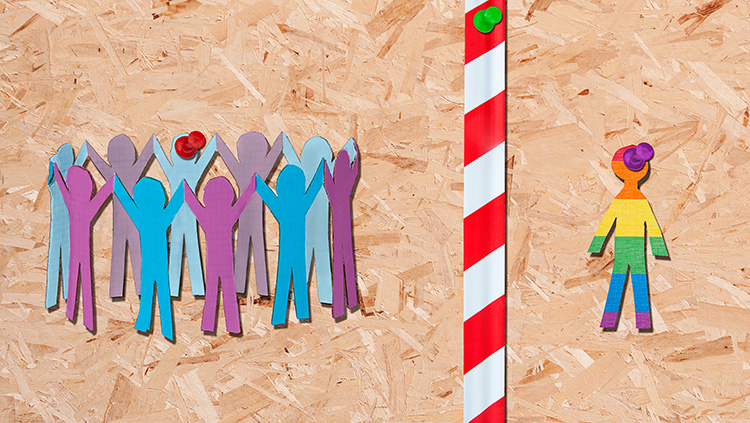Raise the barrier. Photo: Hanselphoto (Getty)
The “buffer seat.” We’ve all seen it. You’re sitting in a theater waiting for the promos to start when a couple of guys walk in. One sits down and the other leaves a space between him and his friend, creating an empty seat so it looks like Casper is hanging out with these straight bros. Some say that the buffer seat is for comfort, more room for manspreading and armrests. I once witnessed this being done with three guys, a seat between each of them and thought to myself whether any of them felt awkward about the forced distance.
These “no homo” behaviors don’t actually stem from a desire to feel comfortable. Buffer seats, buffer urinals, buffer walking spaces — in the end, it all comes down to not wanting to be thought of as gay, as well as the “discomfort with platonic male-male intimacy.” Besides the overarching problem of homophobia, there are two important issues that need to be addressed: Men who are socially conditioned to reject intimate relationships with their friends, aka, toxic masculinity, and straight allies who advocate for the LGBTQ community but still exhibit “no homo” behaviors.
Change Starts Early: 7-Year-Old Defiantly Stares Down Homophobic Preacher During LGBT Festival
Conditioning
UCLA Professor Juliet Williams explained that guys exhibiting these behaviors come from heterosexual social constructs of masculinity: “Things we associate with manhood — such as independence, self-sufficiency — lead men to believe they have to be far away from each other. Which is really kind of sad.”
We see this all over social media, too. You can’t come across a post on Twitter of one player comforting his crying teammate after a big loss by holding him without a mix of nasty homophobic remarks, the usual ignorant complaints on how “real” men don’t cry, and, thankfully, positive comments from people saying that men should be allowed to comfort their friends and have feelings.
A study by Psychology Professor Niobe Way found 14-year-old boys speak lovingly about their guy friends, but when they graduate, they have been socially conditioned “how to perform masculinity” in a way that “involves not needing intimacy.”
“So what you’re seeing with the buffer seat is this interesting contradiction — men want intimacy and closeness, so they’re going to the movie together, but the movie itself is a buffer against intimacy. It’s something they can do together without having to interact; without having each other as the object of each other’s attention… [The buffer seat] says, ‘Yes, we’re together. But not like that.’ It’s about homophobia, but it’s not just about homophobia. It’s about this rule that men don’t need or want to be close to other people.”
Heteronormativity not only perpetuates homophobia but it also creates a barrier for men from necessary platonic connections because of the way they were socialized to accept toxic masculinity.
Educating Straight Allies
On the surface, “no homo” is often turned into a joke. For example, a photo online shows two best friends hanging out, but maybe they appear to be keeping a distance from one another as they walk. Sure enough, you’ll start seeing “no homo bro” teasing, but those behaviors only further the idea that being gay is a bad thing and gives homophobia more power as well as not allowing for platonic relationships to comfortably exist.
We’ve come a long way but still have a long way to go even among advocates, especially with the trend among straight allies who mean well but consciously or unconsciously continue to participate in behaviors that scream “please don’t mistake me as gay” even as they talk about advocating for the LGBTQ community. When allies speak out in support of equality, love, and acceptance, it’s disheartening when they also exhibit behaviors that make it clear they are still worried about being seen as queer.
It’s hard to break free of heteronormativity when it has been normalized for as long as it has been, especially when influenced by hatred and ignorance. Being moved by a male straight ally’s efforts to call for change before witnessing them avoiding platonic intimacy with their guy friends is painful and frustrating, which is why we need to address the social conditioning head-on instead of joking it away.
Stay In Your Lane?: Study Shows Everyone Is A Little Gay, A Little Straight
Creating Change
This isn’t an attack on straight allies; we need all of the support we can get. But we need to confront how “no homo” behaviors are implicitly homophobic, and how counterproductive it is when straight allies are the ones engaging in those behaviors. It’s a call to action to challenge heteronormativity and toxic masculinity in a society that conditions boys to grow up as men not allowed to have emotional or intimate relationships with their male friends.
These backward societal constructs are not set in stone, though. The only way to continue normalizing LGBTQ in society along with intimate platonic relationships without those barriers is through action and education. And to you straight allies: If you’re going to be a face for change, continue to learn and grow so you will also practice what you preach.












